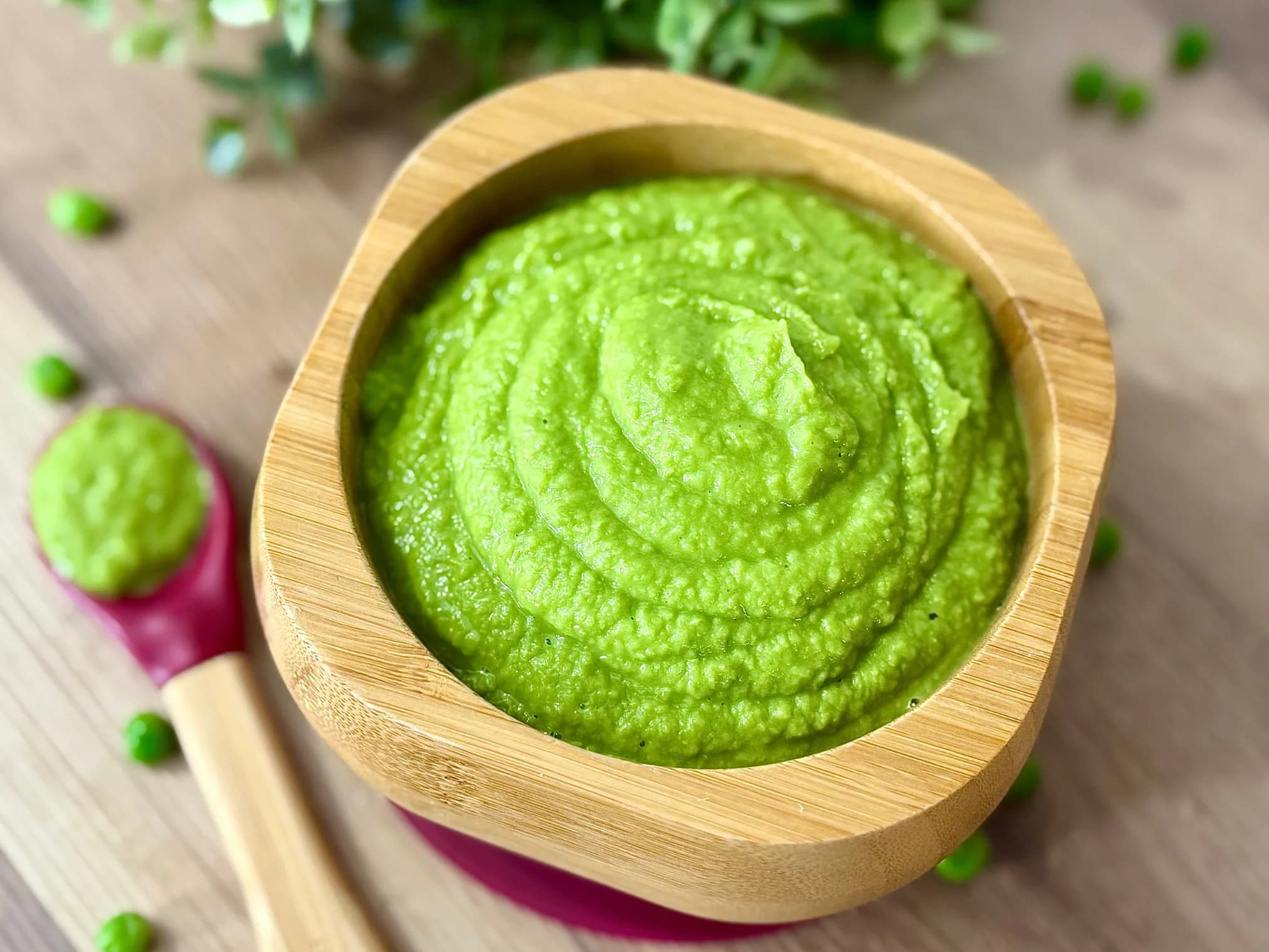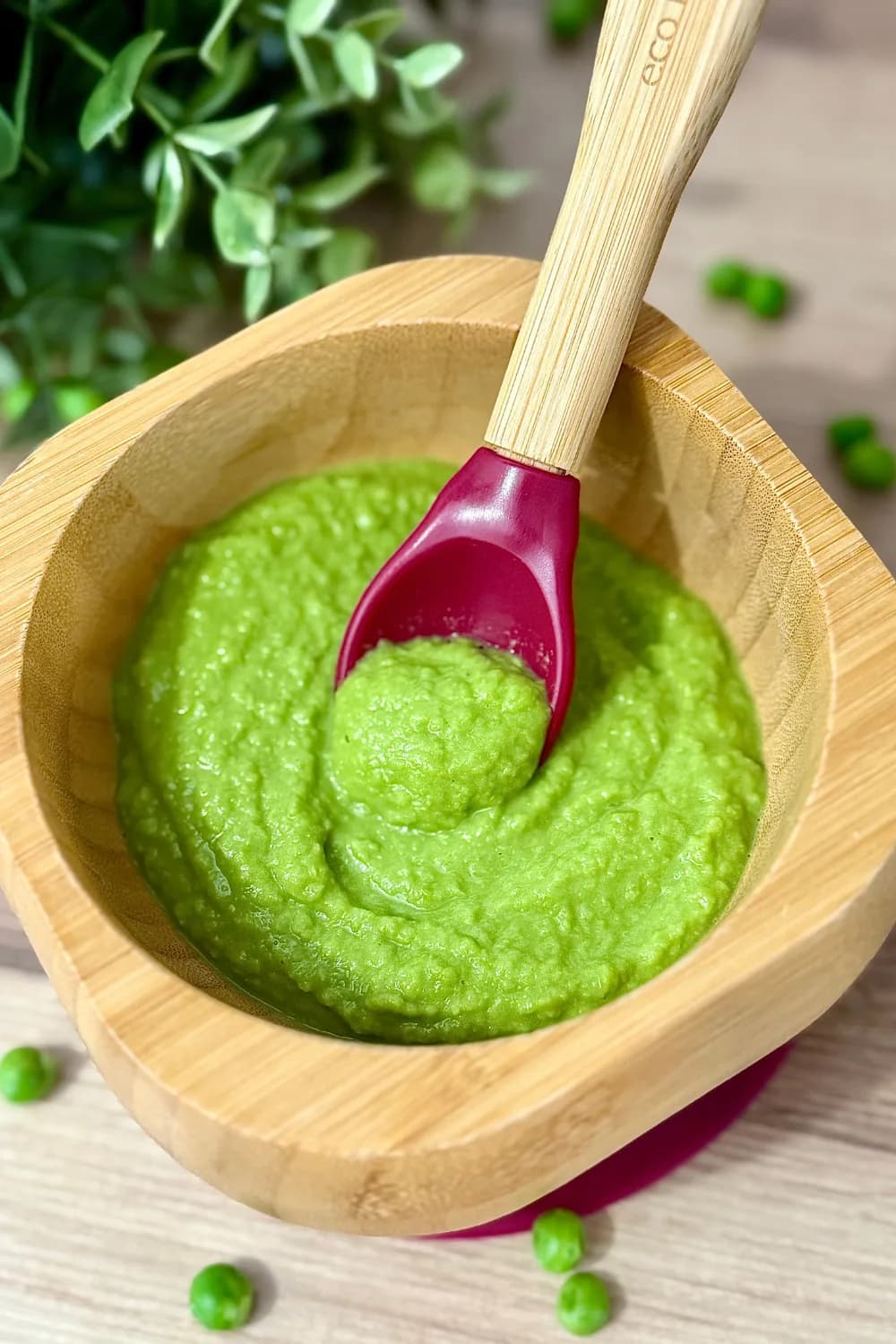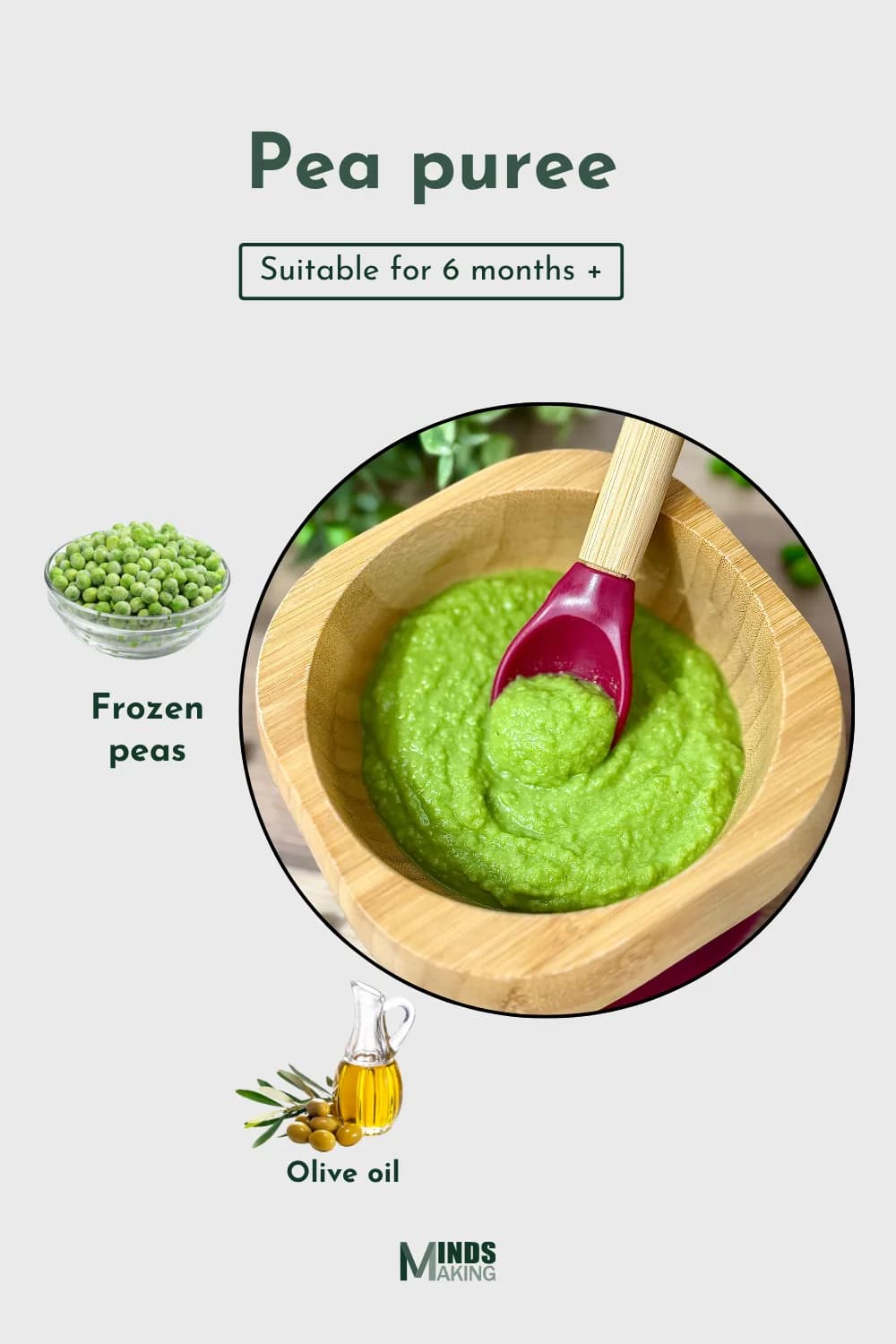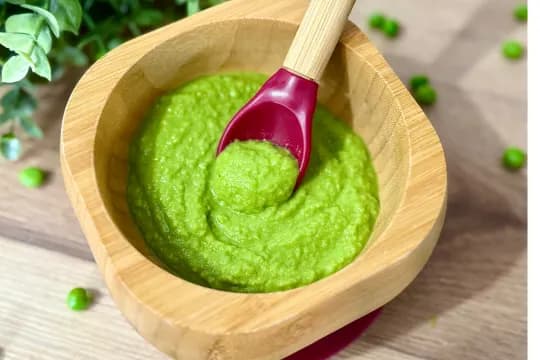Pea puree (Homemade Baby Food)

Written by Kenny Ekerin
Fact Checked by Mindsmaking Professionals
24th, November, 2025
This post may contain affiliate links. Please read our disclosure policy.
Looking for a healthy and easy first food for your baby? This pea purée recipe is packed with vitamins, fiber, and protein. Simple to make and perfect for weaning, it’s the ideal choice to introduce solids to your little one.

Reasons to Love this Pea Purée For Babies
Pea purée is packed with nutrients. Peas are rich in vitamins like A, C, and K, as well as important minerals such as iron, magnesium, and potassium. They also contain fiber and protein, making it a well-rounded and nutrient-dense food for your growing baby.
Second, it's gentle on your baby’s tummy. Peas are easily digestible, making them a great choice for babies starting solids. The purée is smooth, making it easy for babies to swallow, and can be adjusted in consistency to suit your baby's development stage.
Third, this pea purée is simple to make. The recipe requires just a few ingredients—peas, water, and an optional splash of olive oil—making it a cost-effective and fuss-free homemade baby food. It’s quick to prepare, so you can have a healthy meal ready for your baby in no time.
Another reason to love it is that it’s versatile. While pea purée is delicious on its own, it also pairs well with other fruits, vegetables, or proteins. You can mix it with sweet potato, carrots, or even chicken to introduce a variety of flavors to your baby’s palate. This versatility allows you to create different meals as your baby’s taste preferences evolve.
Lastly, pea purée is great for building healthy eating habits. By introducing your baby to a wide range of vegetables early on, you’re setting the foundation for them to enjoy nutrient-rich foods as they grow. Peas are a naturally sweet and mild vegetable, which makes them appealing to babies and helps them develop a taste for veggies without added sugar or salt.
Overall, this pea purée is a nutritious, easy-to-make, and versatile food that your baby will love, making it a wonderful addition to their diet.
Pea Puree Recipe
Ingredients:
- 2 cups of fresh or frozen peas
- 1 tablespoon olive oil (optional)
- Steamer water (reserved from steaming the peas)
Mindmaking

Instructions
1. Prepare the Peas: If using fresh peas, shell them first. If you're using frozen peas, simply measure out 2 cups.
2. Steam the Peas: Place the peas in a steamer basket or a steaming tray. Make sure the peas are spread out evenly for consistent steaming. Bring a pot of water to a boil, then place the steamer basket over the pot, making sure the peas are not submerged in the water. Cover the pot with a lid and steam the peas for about 5–7 minutes, or until they are soft and tender. Once the peas are done, carefully remove them from the steamer. Save the steamer water as it can be used to help blend the peas into a smoother consistency.
Mindsmaking

3. Blend the Peas: Transfer the steamed peas into a blender or food processor. Add 1 tablespoon of olive oil (optional). This can help give the puree a creamier texture and add a bit of healthy fat. You can skip this if you prefer. Add some of the reserved steamer water a little at a time. Start with a small amount and blend, checking the texture after each addition. Continue adding water until you reach the desired smoothness. If you want a thicker puree, use less water; for a thinner consistency, add more water.
Mindsmaking

4. Blend to Desired Consistency: Blend the peas until smooth. Depending on your baby's age and stage of eating, you can adjust the consistency. For younger babies, a very smooth puree is ideal. Older babies may prefer a slightly chunkier texture.
Mindsmaking

5. Taste and Serve: Once the puree is at the desired consistency, you can taste it to ensure it’s mild and suitable for your baby. Serve the pea puree immediately or store it in an airtight container in the refrigerator for up to 3 days. If you're making a larger batch, you can freeze the puree in small portions (like ice cube trays) for later use. This will help preserve the nutrients and make it easy to defrost individual portions.
Read This Next

Recipe Ebook
Essential Guide to Starting Solids for Babies 6 Months+ - LBH Top 70 Baby Puree & Porridge Recipes eBook.
Start your baby’s solids journey with confidence using this "70 Baby Purees & Porridges" eBook! Created with care, this digital guide is packed with nutrient-rich recipes for babies 6 months and older, including purees and porridges tailored to each stage of your baby’s development.
Mindsmaking

Tips for Making the Best Pea Puree
Choose Fresh or Frozen Peas: Fresh peas can be more flavorful, but they may be harder to find and are often available only seasonally. On the other hand, frozen peas are just as nutritious and convenient. They are picked and frozen at their peak freshness, which helps preserve their vitamins and flavor. Either option will work well, so choose based on availability and preference.
Steam, Don't Boil: Steaming is a gentler cooking method that helps retain the peas' nutrients, color, and flavor. If you boil them, they can lose some of their vitamins and might become waterlogged.
Use the Right Amount of Water: When blending the peas, be mindful of the amount of water you add. Start with a small amount of reserved steamer water and gradually add more until you achieve the desired consistency. This prevents the puree from becoming too watery or too thick. You can also use breast milk or formula to thin the puree if you prefer.
Consider Olive Oil: Adding a tablespoon of olive oil (or another baby-safe oil, such as avocado oil) can enhance the texture of the puree, making it creamier. This is especially helpful if you're looking to add healthy fats that are important for brain development. However, this step is optional, and you can skip it if you'd prefer a simpler puree.
Blend to the Right Consistency: For younger babies, aim for a smooth, lump-free puree. Use a high-powered blender or food processor to ensure a silky texture. For older babies, around 8-10 months, you can leave the puree a bit chunkier to encourage them to explore different textures. Just make sure the consistency is suitable for their developmental stage.
Avoid Salt and Seasonings: Babies’ kidneys are still developing, so it's important not to add salt to baby food. High amounts of salt can be harmful. Keep the puree simple and unsweetened.
Watch for Allergies: Though peas are not a common allergen, it’s always a good idea to introduce new foods one at a time. Wait a few days after introducing peas before trying anything else, so you can monitor for any allergic reactions. This cautious approach helps you identify any potential sensitivities early.
Serving Suggestions
1. As a Standalone Puree: Pea puree is perfect on its own as a simple, nutritious meal for your baby. Serve it in a small bowl or a baby-friendly dish. If your baby is new to solids, you can offer a spoonful and allow them to explore the texture. For younger babies, keep the puree smooth and thin it with a bit of breast milk, formula, or water.
2. Mixed with Other Vegetables: As your baby grows and becomes accustomed to different tastes, you can mix the pea puree with other vegetable purees like Carrot puree, sweet potato puree, or butternut squash puree pair well with peas. You can blend these together for a more complex flavor and added nutrients. For a more textured meal, you can combine the purees into small chunks, depending on your baby's stage.
3. With Baby-Cereal or Oats: For a more filling meal, mix the pea puree with some iron-fortified baby cereal or oats. This provides a balance of carbohydrates, fiber, and protein. You can adjust the consistency based on your baby’s preferences, making it thicker or thinner with milk or water.
4. Spread on Whole Grain Toast (for Older Babies): If your baby is ready for finger foods, spread the pea puree on a piece of whole-grain toast or a whole wheat cracker. This offers a new texture for your baby to explore and helps develop self-feeding skills.
5. Serve with Small Pieces of Soft Veggies: For babies who are starting to practice self-feeding, serve pea puree alongside small pieces of soft-cooked veggies like carrot sticks, zucchini, or sweet potatoes. This encourages your baby to use their hands and practice their pincer grasp.
6. Add to Pasta or Rice (for Toddlers): Once your baby is accustomed to different flavors and textures, you can add pea puree to small pieces of pasta, rice, or couscous. This combination can create a balanced meal full of nutrients and flavors. For an added twist, top it with some grated cheese if your baby has already been introduced to dairy.
7. Mix with Protein Purees: You can also mix the pea puree with protein-rich foods like chicken puree, turkey puree, or tofu for a well-rounded meal. Just cook the protein source thoroughly, blend it with some steamer water, and combine it with the pea puree for added flavor and nutrition.
8. Frozen as a Treat: If your baby enjoys teething toys, you can freeze the pea puree into small cubes or popsicle molds for a cool, soothing treat. The cold texture can help ease teething discomfort while still providing a nutritious snack.
How to Store
If you plan to use the pea puree within a few days, store it in an airtight container in the refrigerator. It will stay fresh for about 3 days. Make sure the container is tightly sealed to prevent contamination and maintain the puree’s flavor and texture. Always allow the puree to cool to room temperature before placing it in the fridge.
For longer storage, freezing is the best option. To freeze pea puree, portion it into ice cube trays or small containers. This way, you can defrost individual portions as needed. Once the puree is frozen, transfer the cubes into a freezer-safe bag or container. Label the bag or container with the date, so you know when it was made. Frozen pea puree can be kept for up to 3 months. When you're ready to use it, simply defrost the cubes in the refrigerator overnight, or warm them up in the microwave or on the stovetop.
Dividing the puree into small portions is a helpful strategy when storing it. This minimizes the need to thaw and reheat larger amounts, which could affect the texture and nutritional value. You can use ice cube trays, small baby food containers, or even silicone muffin trays to create convenient single-serving portions.
Silicone storage bags or containers are also a great option for freezing baby food. They are durable, easy to clean, and can be squeezed to remove excess air, helping preserve the food longer. If you've mixed the pea puree with other ingredients, such as baby cereal or mashed vegetables, you can also freeze it as a whole dish. Just make sure to portion it appropriately for easy thawing and serving. Remember to label and date it for easy identification.
Nutrition
Suitable for 6 months +
(per serving, approximate):
- Calories: 60-80 (depends on additional ingredients like olive oil or milk)
- Protein: 3-4g (peas)
- Healthy Fats: 1-3g (olive oil, if using)
- Carbohydrates: 12-15g (peas)
- Fiber: 4-6g (peas)
- Vitamin C: from peas
- Calcium: a small amount from peas
- Iron: from peas
- Omega-3s: trace amounts (if using olive oil)
Note: Nutritional values are estimates and may vary based on ingredient brands and portion sizes. Adding other ingredients, such as formula, breast milk, or additional vegetables, may alter the nutritional profile.
Frequently Asked Questions
At what age can I introduce pea purée to my baby?
Pea purée is suitable for babies starting solids, typically around 6 months of age. Always consult your pediatrician before introducing new foods, especially if your baby has a history of allergies.
Is pea purée safe for babies with allergies?
Peas are not a common allergen, but as with any new food, introduce them on their own and wait 3–5 days before introducing another new food. Watch for signs of an allergic reaction such as rash, swelling, or digestive discomfort.
Can I use frozen peas instead of fresh?
Yes! Frozen peas are just as nutritious and convenient. They’re often frozen at peak ripeness, which helps preserve their nutrients and flavor. Just be sure to steam or cook them thoroughly before blending.
Why is steaming better than boiling for peas?
Steaming preserves more nutrients, color, and flavor than boiling, which can leach vitamins into the water. Always save the steamer water to blend the purée — it adds back some of the lost nutrients and helps with texture.
How smooth should the purée be?
For younger babies (6–7 months), aim for a very smooth, lump-free texture. As your baby gets older (8–10 months), you can make the purée slightly thicker or chunkier to introduce more texture and encourage chewing skills.
Can I add anything to the purée for extra nutrition?
Yes! A small amount of olive oil or avocado oil adds healthy fat, which supports brain development. You can also blend in breast milk, formula, or other purées (like carrots or sweet potatoes) to boost flavor and variety.
Is it okay to add salt or spices to pea purée?
No. Avoid salt and added seasonings for babies under 1 year, as their kidneys are still developing. Peas have a naturally sweet flavor that babies usually enjoy on their own.
How should I serve pea purée?
As a standalone meal Mixed with other veggie purées (e.g., carrots, squash) Stirred into baby cereal or oats Spread on toast or crackers (for older babies) Combined with protein purées like chicken or tofu Served with soft veggie sticks as a dip Frozen into teething-friendly cubes
How do I store leftover pea purée?
Fridge: Store in an airtight container for up to 3 days. Freezer: Freeze in ice cube trays or silicone containers for up to 3 months. Defrost overnight in the refrigerator or reheat gently before serving. Always allow to cool before serving to your baby.
Can I batch cook and freeze pea purée?
Yes! Pea purée is ideal for batch cooking. Freeze in small portions for easy thawing and serving. Use labeled freezer bags or baby food containers to keep track of the date and contents.
Was this article helpful?
How many stars are you giving this article?
Leave a comment
Your email address will not be published.
Comments
More From Recipe

Apple & Plum Puree

Sweet Potato Frittata

Banana Carrot Puree

Apple, Peas & Potato purée

Carrot & Banana Muffins

Baked Cheesy Plantain Fritters
Get new recipes to your inbox
Subscribe to our weekly newsletter and get new recipes sent to your inbox!